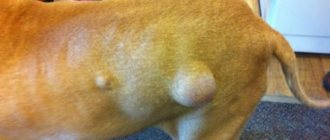Content
1. Causes of bumps on the paws of dogs 2. What does the color mean? 3. Allergic reactions 4. Appearance 5. Oncology 6. How to help a dog before visiting a veterinarian?
Any adequate pet owner from time to time examines his pet for the appearance of various injuries, injuries, as well as neoplasms. And at some point in time, the owner may notice bumps on the dog’s paws. These formations can be very different, both in color and size, and in the pain they cause. However, in any case, this issue must be taken as seriously and responsibly as possible. It is important to correctly diagnose the causes and prescribe timely, effective treatment.
Prevention measures
The best prevention is careful adherence to the rules of keeping the animal - paw hygiene, organization of a healthy lifestyle, regular visits to the veterinarian.
To comply with these rules you must:
- promptly shorten overgrown claws;
- trim the hair growing between the toes and around the pillows;
- regularly deworm and destroy skin parasites;
- keep the dog clean;
- wash paws after walks.
Be attentive to your pet. The sooner you notice symptoms and take action, the sooner recovery will occur.
Causes of bumps on dogs' paws
These types of growths can appear for a variety of reasons. However, the most common among them are the following:
- mechanical injuries, blows, cuts, etc.;
- bites of various insects, especially ticks;
- skin damage, as an option, rubbing;
- incorrect, unprofessional injections into the animal’s paws (in general, trust only a specialist to give the injection - this will save your pet from many problems);
- a complication that sometimes occurs after surgery;
- abnormal functioning of the so-called sebaceous glands;
- infection, in which a colony of bacteria or other harmful microorganisms multiplies in one small place;
- complications associated with chronic illnesses;
- allergies – in some cases, bumps appear on dogs’ paws as a reaction;
- fungi;
- arthritis, simply changes in the structure of the joints associated with the age of the pet;
- genetic characteristics of an individual organism;
- consequences of dystrophy, illiterate, unbalanced nutrition, lack of vitamins;
- oncology.
If you have discovered a neoplasm, it is quite difficult, almost impossible, to clearly name the cause of its appearance. For more accurate diagnosis, technologies such as puncture, MRI, radiography and some others are used. However, some, albeit incomplete, information. It can also be obtained at the preliminary stage of inspection.
Causes of tumors, neoplasms and cysts
- Sebaceous cysts, adenomas and adenocarcinomas
- Moles on the skin
- Histiocytomas
- Squamous cell carcinoma
- Malignant melanoma
- Oral growth in dogs
- Lipomas
- Mast cell tumors
- Breast tumors
- Abdominal masses
- Lymphoma of dogs
- ... and much more, including cysts (not sebaceous glands), hematomas, infections, inflammatory reactions and tumors resulting from injury.
What does the color say?
Lumps on a dog's paw can come in a variety of colors. And some information about the problem can be obtained from the color of the bulge.
| Red | If there is swelling and/or puffiness, it indicates a possible abscess, an allergic reaction, for example to a tick bite or a medicine. We can also talk about a malignant tumor. |
| Pink | In this particular case, with a high degree of probability we are talking about papillomas or malignant, as well as benign neoplasms. For obvious reasons, only a qualified veterinarian can make an accurate diagnosis. But the soft texture of a lump on a dog's paw indicates that the tumor is most likely benign and operable. |
| Black | This may turn out to be an ordinary hematoma or wart, or a cyst. |
Why all this reasoning? You cannot use any therapeutic actions, for example, warming up with external heat sources, opening swellings, even applying any ointments is highly discouraged. And not only because dog owners, as a rule, do not have the appropriate experience and skills, but rather, this is due to the fact that treatment errors with an incorrect diagnosis are fraught with serious consequences, even death.
Abscess
Abscesses most often appear on the surface of the skin, but there can also be an internal abscess, which is more severe and complex. Growths associated with infection appear as a result of mechanical trauma, cuts, and scratches. In this case, dirt, debris, wood, and glass may get onto the damaged area. Naturally, inflammation and abscess follow. Subcutaneous mites are also often the cause of the growth.
Under no circumstances should you open up lumps on your dog’s paws that are caused by an abscess. The fact is that the wound contains a large number of microbes, bacteria, and other pathogenic organisms. If opened incorrectly, they may enter the bloodstream. In this case, they will spread throughout the body, quickly affecting healthy cells and organs. As a result, the likelihood of blood poisoning and death is extremely high. Just like that, they simply opened the appendix, and the result was disastrous.
Conclusion: contact a veterinary clinic, where the operation will be performed by professionals using sterile instruments and materials.
Pododermatitis
Extremely unpleasant growths and swellings can form between the toes of dogs with pododermatitis.
The most important thing is that they do not just cause some discomfort, but cause real pain. As a result, the pet becomes inactive and prefers to lie quietly. If necessary, he begins to limp and sometimes even whine pitifully.
There is a certain risk group for breeds for which bumps on the paws of dogs in the form of pododermatitis are most relevant.
Among them are: Labradors, shepherds, primarily German, bulldogs and some others.
Owners of representatives of such breeds need to regularly, more often than usual, inspect the llama's pads and the space between the toes.
In the process of treating this disease, owners will be asked to radically reconsider the conditions of keeping the animal. In the vast majority of cases, the problem becomes urgent due to poor nutrition, lack of necessary vitamins, amino acids, and the dog’s constant presence in a damp room.
Treatment
A foreign body can be treated in this way . Soaking the foot in a warm salt bath for 5-10 minutes twice a day can help clear the infection and speed up the healing process.
The foreign body will either get out or form an abscess (a pus-filled growth) and will require antibiotics. Consult your veterinarian for more information on treatment options.
© shutterstock
Histiocytoma is often alarming to dog owners because they seem to appear overnight, although they often disappear within a few months.
When they continue to grow, they are sometimes surgically removed. A course of prednisone may help them shrink.
Any strange growths you find on your dog should be examined by a veterinarian, as there is always a chance that they are cancer. Cancer can affect a dog's toes, bones, paw pads, and skin on his feet.
Cancer should be detected immediately because time is of the essence. If infected early, the cancer can be removed, although sometimes this may mean amputation of footpads, toes or even paws.
Allergic reactions
Of course, allergies can manifest themselves in the most unpredictable, sometimes even very original and bizarre ways.
In particular, in dogs it often manifests itself in the form of bumps on the paws. The reaction may be to insect bites such as ticks, mosquitoes or fleas, or to injections, alternatively, during vaccinations. It is worth understanding that these types of symptoms go away quite quickly on their own. However, in cases where this does not happen, it is necessary to seek advice from a veterinary clinic. It is advisable to do the same if the dog has active itching at the site where the lump appears.
Hematomas and warts
Internal tumors
Some dogs develop internal masses in the chest or abdomen, especially older dogs. Internal masses may be discovered because of the symptoms they cause (such as difficulty breathing or vomiting) or during a routine medical examination.
Internal lesions can be benign or malignant and are usually definitively diagnosed through a combination of x-rays, ultrasound, laboratory tests, and biopsy. Treatment depends on the location and type of tumor.
Appearance
| Warts | On the skin they are quite common in dogs of smooth-haired breeds. This is not to say that this is some kind of scourge, but they can cause quite real troubles. Warts come in different colors and sizes. It is important to understand that it is necessary to remove growths only if they clearly interfere with the animal. Otherwise, veterinarians will not even “talk” on this topic. |
| Hematomas | These are formations that appear after mechanical blows from the paws. They are usually soft and dark, black in color. If their appearance on the body can still be taken calmly, then on the paws it is worth paying at least close attention. The fact is that bruises, as a symptom, can also characterize a more serious injury than a bruise. It could be a ligament rupture. Ideally, you need to observe for a day. And if there is no improvement, then be sure to consult a doctor. By the way, if you take a pet with a hematoma straight to the veterinary clinic, it will definitely not get worse. |
Associated symptoms
Benign formations
should not be accompanied by any additional symptoms.
Malignant formations
, on the contrary, will worsen the pet’s quality of life. Usually in the early stages the dog does not experience obvious discomfort. As the formation grows and progresses, the pet may feel pain and weakness. Tumors often metastasize to the lungs, after which the animal will have difficulty breathing and shortness of breath. The tumor can spread to many organs and tissues, which leads to a decrease in their performance and the death of the animal.
Abscess
can often be accompanied by increased body temperature, lethargy, and refusal to eat.
The abscess itself is painful to the touch and gives the pet discomfort. Allergies
can go from harmless rashes all over the body to life-threatening swelling of the respiratory tract.
A small, non-strangulated hernia
usually does not cause discomfort to the animal. When the hernial ring is pinched, it becomes painful and hard. With prolonged compression, the tissues die and the pet may die.
Oncology
As in people in the initial stages, malignant neoplasms do not cause any particular trouble or any discomfort. It’s not surprising that owners don’t pay attention to the bumps on their dogs’ paws – everything seems to be normal. And this continues until metastases affect important organs. In this case, the real torment of the animal begins. In this case, it is impossible to provide effective assistance; the only option left is euthanasia. If only for this reason, you should not ignore growths on the limbs.
Yes, contact your veterinarian, take the necessary tests, undergo a course of treatment and enjoy a long and fulfilling life for your pet!
Diagnostics in a veterinary clinic
To make a correct diagnosis of a dog, a veterinarian will need to examine the animal and do a number of necessary diagnostic tests, including:
- general and biochemical blood tests;
- Analysis of urine;
- Ultrasound;
- biopsy for histological examination of tissue;
- fingerprint smear - to determine cell atypia or the presence of an infectious agent;
- computed tomography - if a malignant tumor is suspected;
- radiography - to determine the depth of penetration of the lump into the soft tissue.
According to indications, additional diagnostic methods can be used to obtain more complete information.
When does your dog need a biopsy?
If fine needle aspiration is not effective (or if the veterinarian feels it is not the best option), the next recommendation is usually a biopsy.
The biopsy is often performed on the dog under general anesthesia or sedation, but local anesthesia may be used instead depending on the size and location of the mass.
A biopsy can be performed using a special large needle. Or the veterinarian may surgically cut the mass. In some cases, the entire mass is surgically removed and sent to a laboratory for identification.











